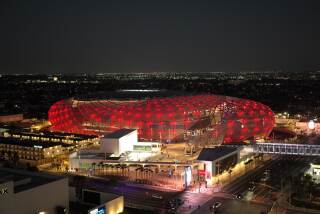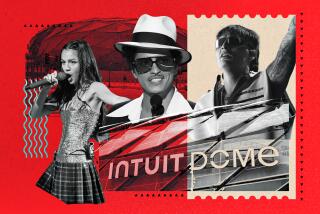Tokyo’s Window of Opportunity
- Share via
TOKYO — An enormous yet somehow intimate gathering place, the eye-shaped main hall of the new Tokyo International Forum is what its creator, architect Rafael Vin~oly, calls an “urban room.”
Despite its massive size on an oddly triangular 6.7 acres, the arts and conference center--which opened Friday with performances ranging from Western classical music to traditional Kabuki theater--nestles unobtrusively between the neon-lit Ginza entertainment district and the gray, uniform buildings of the Marunouchi business district in downtown Tokyo. There is enough space to host groups of 30,000 people, and the buildings stretch over and alongside a network of train and subway tracks.
“The idea is that the building is not just a performing arts center, not just a convention center, but rather a mix of things that are thought to create a synergy among themselves,” Vin~oly said.
The seven-story Glass Hall, the Forum’s main lobby, has a ceiling that soars like the cavernous dome of a transparent cathedral. Its size and arc prompted Vin~oly to compare its spirit to that of New York’s Grand Central Station. It is, he says, a place for the civic interaction of the 21st century.
The $1.5-billion center is already being hailed internationally as a success, with comparisons to Sydney’s Opera House and New York’s Lincoln Center for both its massive scale and its function as a cultural and intellectual hub. Tokyo has long held a reputation as an economic powerhouse, but as a center of international culture it still ranks below the likes of New York and London. The Tokyo Metropolitan Government is hoping all of that will change now.
“As Tokyo becomes more and more important as a transmission point for culture and information, the Tokyo International Forum will be deeply meaningful as a center for international exchange,” Tokyo Mayor Yukio Aoshima said at Friday’s opening festivities.
Envisioned by city planners as a place alive with people 24 hours a day, the new complex contains, in addition to the Glass Hall, four concert halls, an entire wing of conference rooms, an exhibition hall, an art gallery and a multitude of restaurants and cafes.
The back of the Glass Hall curves gracefully along a line of train tracks. Between its sheer front wall and the complex’s four auditoriums is a tree-lined outdoor plaza, which draws in pedestrians and spills them out again near the train stations on either side.
The opening of the Forum has not only given Tokyo a symbolic landmark, but also is the largest commission to date for New York-based designer Vin~oly, who was selected in 1989 through an international competition that garnered 395 entries from 68 countries.
A 1969 graduate of the University of Buenos Aires Faculty of Architecture and Urbanism, the Uruguayan-born Vin~oly and several colleagues started what has become one of South America’s largest architectural firms. In 1979, he emigrated to New York, and four years later established his present company, Rafael Vin~oly Architects. Among his current projects are a 23-story Samsung Corp. building in Seoul, a stadium at Princeton University and a Bronx courthouse.
The Forum’s glass atrium has been praised as a major feat of engineering, made earthquake-resistant by engineer Kunio Watanabe. Its 3,000-ton ceiling rests on two steel columns and is supported by steel ribs that hang down from above like the skeletal hull of a ghost ship.
From its ground-level entrance, the hall seems unremarkable. But from the sunken concourse below, the soaring ceiling’s bowed shape and the zigzagging bridges high above that connect the performance halls to the conference rooms create a cavernous sense of space.
The visual impact of the Glass Hall’s roof may make the building a landmark, but it is the Forum’s accessibility that made Vin~oly’s plan the top choice. Even the performance hall lobbies facing the plaza are glass-walled, further enhancing the feeling of openness on the plaza. There is a sense of constant flow in the system of bridges in the Glass Hall and in the concourse beneath the performance halls and the center of the complex.
The last of three enormous civic structures built with the support of former Tokyo Mayor Shunichi Suzuki, the Forum is to some a monument to the economic power and prowess that Japan enjoyed during its 1980s “bubble economy,” a spending-spree period of inflation in stock and real-estate prices. Suzuki was widely criticized for using public funds for such projects, and his Notre Dame-esque Tokyo Metropolitan Government building was dubbed a “tax tower”; still, plans for the Forum went forward.
Construction took six years, an accomplishment that Vin~oly called “an extraordinary team effort.” During that time, Vin~oly commuted between New York and Tokyo twice a month.
Now that the Forum’s magnificent framework is complete, the question is what kind of soul it will have. Friday’s opening ceremony in the 5,000-seat auditorium provided a glimpse of what officials hope to achieve. The program began with the Tokyo Metropolitan Symphony Orchestra playing Western classical music and ended with Kabuki.
The mix of East and West seemed to represent the city’s desire to use the Forum to make Tokyo truly cosmopolitan. The sustained applause that followed suggested they may get their wish.
More to Read
The biggest entertainment stories
Get our big stories about Hollywood, film, television, music, arts, culture and more right in your inbox as soon as they publish.
You may occasionally receive promotional content from the Los Angeles Times.










